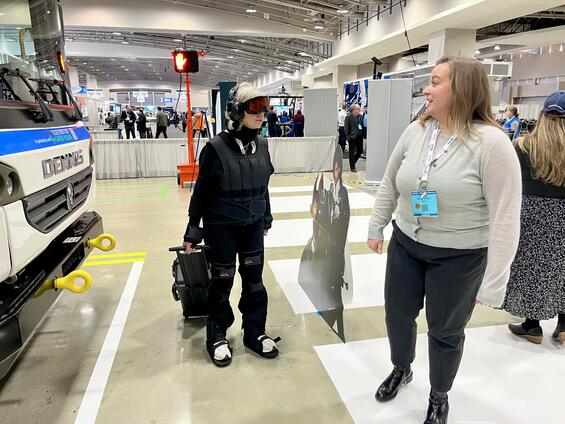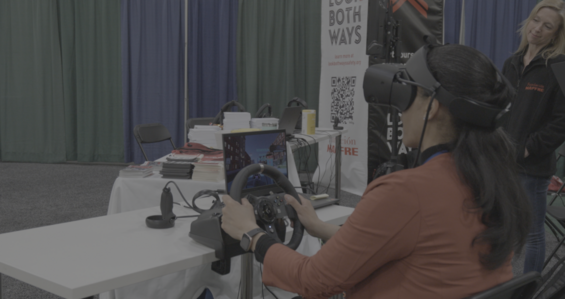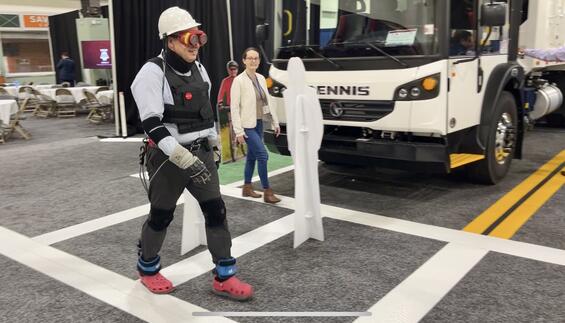What we’re doing/the experiment
We designed and facilitated the Empathy at the Intersection experience for the 2024 MassDOT Innovation Conference and again for the 2025 Transportation Research Board Annual Meeting. We wanted to draw attention to the various lived realities of people using Massachusetts's roads. As individuals, we’re used to our preferred travel method and our experiences. Whether that be in a car, on a bicycle, walking, riding transit, or driving a large vehicle for your job.
Each activity asked participants to step into the shoes of someone else on the road. The center of the experience was a full-size replica of an intersection with four to six activities scattered throughout. People did as many of these activities in whatever order they wished. This allowed them to customize their experience and go at their own pace. If you are looking to bring this to an event, let us know. While we can’t dedicate the time to run it, we learned quite a bit and can share our toolkit with you.
Video: Empathy at the Intersection
Skip this video Empathy at the Intersection.Elements of the experience
We designed Empathy at the Intersection to include experiences for participants that would help them build empathy and understanding for different road users. The MassDOT Conference and TRB Annual Meeting were comprised of different sets of experiences focused on empathy building.
The TRB Annual Meeting was our second time facilitating the exhibit and was designed for a larger audience. One experience invited participants to check out what a driver can see from the cabs of two different trucks. One truck with a conventional cab design and one cab with a design for higher visibility. This visibility is called Direct Vision, the area visible to the driver using their eyes alone, without the aid of cameras or mirrors. Direct Vision is proven to improve reaction times for drivers, potentially avoiding a crash. The Lab is working on a Direct Vision Study with the US DOT Volpe Center in 2024.

A person steps into the cab of a large truck to check out the visibility from the driver’s seat during the Direct Vision experience at Empathy at the Intersection.
The next experience was a focus on the Bus Operator’s viewpoint through a virtual reality training done in collaboration with Drivers of Tomorrow. Participants could go through an exercise of driving a bus on a regular route or done a pair of VR goggles and proceed through a pre-trip checklist that bus operators perform at the start of a shift.
A second VR experience placed participants in the driver seat of a typical passenger car and asked them to spot pedestrians, cyclists, and motorcyclists as they traveled through a series of streets at the speed limit. Provided by Enshrine Productions, people were tasked with making eye contact for long enough times to acknowledge these vulnerable road users which proved to be a very challenging task.
The final set of experiences analog. First, two different suits to try on. One was designed to simulate aging and the other suit to simulate being pregnant. The gerontological suit or GERT suit, facilitated by Corgan, replicates the physical challenges associated with aging, including limited mobility, decreased vision, and instability. Once suited up, participants were asked to cross the intersection in a set amount of time and perform a series of tasks getting into and out of a vehicle.

A person tries on the age simulation suit and moves through a mocked-up intersection with their luggage.
Finally, Connecticut DOT brought their ‘ADA toolkit experience’. This toolkit features vision impairment goggles, white canes, and wheelchairs. Participants were invited to put on the vision impairment goggles and use the white cane to navigate the intersection which was setup with a series of obstacles. They could also choose to try weaving in a wheelchair through minimum-width ADA-compliant sidewalks featuring an obstruction or try reaching for walk signal push buttons installed at different heights.
This is the view of Empathy at the Intersection. There are two crosswalks, two bike lanes, cardboard cutouts for pedestrians, two trucks, and a series of reflection activity tables at the MassDOT Innovation Conference.
Previously, at The MassDOT Innovation Conference the exhibit was comprised of four activities. In this edition we still showcased the large truck blind zone research, the age suit which was facilitated by the MIT AgeLab, and the vision impairment activities with Connecticut DOT. Fundación MAPFRE provided an experience that invited participants to engage in a virtual reality driving simulation. The simulation kept track of any unsafe behaviors and gave participants a corresponding score. Each glance at a cell phone, each crash with a pedestrian, and each incident with a person on a bike would deduct from their total score. Participants competed with one another to be the safest drivers at the Conference.

A person is at the driving wheel of the simulation, wearing a virtual reality headset and the screen showing their course is displayed on the table in front of them.

A participant in the AGNES suit crosses a crosswalk that also has cardboard cutout pedestrians.
Why we did this
At MassDOT, we aim to be a national leader in the types of projects we take on and the ways in which we approach them. The TRB Annual Meeting and the MassDOT Innovation Conference were opportunities to bring together municipal staff, DOT staff, researchers, and other transportation professionals from across our state and around the world. This exhibit provided an opportunity to further a conversation about community-centered transportation. Empathy at the Intersection was one component of a three-part cohesive thread of the Innovation Conference. The second element was a hands-on workshop. This workshop incorporated some of the Empathy at the Intersection experiences and reflections. The final element was a panel discussion highlighting various state DOT perspectives on building and leading a forward-thinking transportation organization. At the TRB Annual Meeting the exhibit was complemented by a session facilitated by MassDOT’s Chief of Operations called “Measuring Customer Experience: What DOT Leaders Need to Know”
What we learned
We learned to how to pull off a big exhibit with a very small team. Perhaps more importantly though we learned through participant reflections. We offered multiple reflection exercises for each activity. We wanted participants to have an opportunity to internalize the lessons from the experiences. We used tools like empathy mapping and a set of prepopulated questions for each activity. Empathy at the Intersection staff and volunteers were also available for more in-depth conversations with participants who were interested in debriefing verbally. Through this experience we were able to confirm some assumptions about the importance of experiential learning – particularly for participants in the mobility impairments exercise and those who climbed into the driver seat of the two large trucks. As we move forward the Direct Vision body of work feedback was helpful for informing our communications approach.
Empathy mapping exercise showing positive, neutral, and negative reactions in a Say, Think, Feel, Do framework for the Truck Blind Zones reflection activity.
Direct Vision
Feedback indicated that the direct vision experience helped build empathy both for the truck drivers as well as for pedestrians and people on bikes. All around, people felt scared: scared for the drivers with limited visibility on the road and scared for pedestrians and cyclists who struggle to stay in the driver’s line of sight. People also reflected how tiring it must be to drive a truck with low direct vision, constantly trying to see pedestrians in their blind zones.
Many participants had never experienced being in the cab of a truck. What they could, or rather couldn’t, see was surprising.
Urban driving simulation
Following the urban driving virtual reality simulation, many participants reflected on bad driving experiences they had in their own lives. As one participant noted, these situations can happen to anyone. Many participants came away from the simulation noting that they had run over a pedestrian. What did that say about them as a driver? What would’ve happened on a real street instead of in the simulation? One participant told us about a crash they were in shortly after receiving their license. They reflected on how that experience left them hesitant and more careful on the roads.
Crossing with mobility impairment
Participants had very strong reactions to both of the crossing with mobility impairment activities. They described feeling vulnerable, nervous, unsafe, unsteady, and disoriented among other adjectives. One participant reflected, “I’m not as strong as I thought.” We’re so confident in our daily routines and in the ways we typically experience our streets. Many participants reflected on the lives of their family members with certain disabilities and the empathy, patience, and care they feel for them.
Bus operator simulation
Participants enjoyed the challenge of safely navigating down a city street, sometimes at speeds under 10 mph as they got used to operating such a large vehicle. One reflection comment read “this was overwhelming, I have so much respect for bus drivers” and many reflected on the “need to be more polite and kind to bus drivers” who have many things to balance on their routes.
Across all the activities, participants wished that these types of experience were more widely available. One participant from the direct vision activity said, “Leaders should job shadow for greater understanding and develop more informed support programs.” Another noted, “All 3 activities should be available at public meetings.” People engaged with Empathy at the Intersection. Each activity served to draw attention to different aspects of people’s experiences at an intersection.